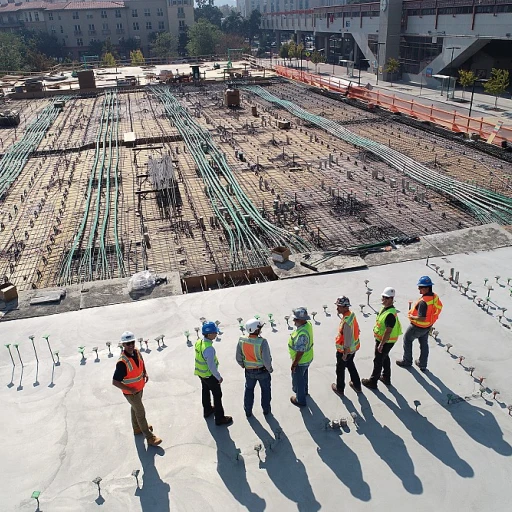
Understanding the Importance of Career Development
The Foundation of Employee Growth
In today's rapidly evolving business landscape, the importance of career development cannot be overstated. As organizations strive to remain competitive, they must prioritize the growth and development of their employees. Career development programs are not just a perk; they are a strategic necessity that can significantly impact employee engagement and retention.
Investing in employee development is akin to investing in the future of the company. It helps employees acquire new skills, align their career goals with organizational objectives, and prepare for leadership roles. This not only enhances their job satisfaction but also contributes to the overall success of the organization.
Moreover, career development is a key driver of employee engagement. When employees see a clear path for career progression and have access to opportunities for professional growth, they are more likely to remain committed to their roles. This commitment translates into higher productivity and a more dynamic workplace environment.
Incorporating a structured development plan within the organization can help fill skill gaps and prepare employees for future challenges. By fostering a culture of continuous learning, companies can ensure that their workforce remains agile and adaptable.
For more insights on how strategic planning can transform human resources, explore unlocking the potential of succession planning.
Identifying Employee Needs and Goals
Determining What Employees Need to Succeed
Understanding employee needs is an essential foundation for crafting impactful career development programs. Each employee brings unique skills, career goals, and aspirations to the organization. Identifying these elements helps in aligning personal and professional growth. To effectively identify these needs, consider the following approaches:- Surveys and Feedback Mechanisms: Regular surveys and feedback channels can help gather insights directly from employees regarding their career aspirations and skills they wish to develop. Surveys must be designed to uncover not just the skills employees want to acquire but also their ultimate career goals.
- One-on-One Meetings: Personalized discussions between managers and employees can uncover deeper insights into individual career paths, providing a platform for employees to express their professional desires. This dialogue should foster an environment where employees feel comfortable sharing their long-term aspirations.
- Employee Performance Data: Analyze existing performance data to identify areas where employees excel and where further training might be needed. This data-driven approach can help in devising precise training programs that fill skill gaps and enhance career progression.
- Consultation with Leadership: Engaging leadership in identifying key competencies and future organizational needs can help tailor development programs to meet both individual and organizational goals.
Designing a Flexible Framework
Building a Dynamic Framework for Career Growth
Crafting an effective career development framework goes beyond mere planning. It requires a flexible structure that adapts to the changing needs of employees and the organization. Such a framework should engage with various levels of employee growth, from entry-level positions to leadership roles, ensuring everyone has a clear path toward their career goals.To achieve this, a few core elements must be present:
- Personalized Development Plans: Employees benefit from personalized development plans that focus on their unique skills and career aspirations. These plans help identify specific plans for skill enhancement and career advancement.
- Mentorship and Leadership Opportunities: Integrating mentorship programs into the development framework ensures that employees have access to guidance from experienced leaders, fostering professional growth and leadership skills.
- Access to Diverse Learning Opportunities: The framework should provide access to a diverse array of learning opportunities, from traditional training programs to cutting-edge online resources, promoting continuous learning and professional development.
- Adaptability to Change: As employee needs and company goals evolve, the framework should be flexible enough to accommodate these changes, ensuring it remains relevant and effective.
Adopting a dynamic approach to career development helps to fill skill gaps and create a more engaged and motivated workforce. It can transform employees into advocates for their own growth, ensuring long-term success for both them and the company. For insights on developing an appreciative culture that seamlessly integrates with career growth initiatives, take a look at this resource on cultivating an appreciative culture in human resources.
Incorporating Technology and Innovation
Leveraging Advanced Tools and Techniques
As businesses strive for effective career development, incorporating technology and innovation becomes essential in crafting dynamic programs. By utilizing cutting-edge tools, organizations can enhance the learning and professional growth of their employees. Digital platforms, for instance, offer tailored opportunities for employee engagement, bridging the gap between current skills and desired career goals.
Utilizing Technology for Personalized Development
Modern technology allows companies to create personalized development plans that address the unique needs and aspirations of each employee. By leveraging AI and data analytics, businesses can identify skill gaps and predict future needs, enabling them to design a development plan that aligns with both company objectives and employees' career paths. These personalized plans not only foster career growth but also enhance employee satisfaction and retention.
Introducing Interactive Training and Learning Opportunities
Interactive and immersive training programs are transforming traditional learning models. Online courses, skill-based workshops, and virtual reality simulations offer employees hands-on experience that stands out from conventional methods. These innovative platforms not only cultivate a culture of continuous learning but also stimulate professional development by providing immediate feedback and real-time adjustments in a safe, controlled environment.
Promoting Continuous Skill Enhancement and Engagement
A continuous development program that integrates technology can significantly boost employee motivation and engagement. By offering flexible learning opportunities and diverse career pathing options, employees feel empowered to take charge of their career growth. Encouraging employees to partake in learning development initiatives ensures that the company remains competitive while supporting each individual’s long-term professional advancement.
Mentorship and Leadership Development via Tech Solutions
Beyond training, technology can also enhance mentorship and leadership programs. Digital platforms can connect employees with mentors across the globe, opening doors to new perspectives and invaluable advice. Additionally, leadership development tools can help identify potential leaders within the organization, facilitate succession planning, and ensure the company thrives over the long term.
Measuring Success and Adapting Strategies
Evaluating the Impact of Career Development Programs
To ensure the effectiveness of career development programs, it is crucial to measure their impact on both employees and the organization. This evaluation helps in understanding whether the programs are meeting their intended goals and how they contribute to employee growth and company success.
Key Metrics for Success
- Employee Engagement: Monitor changes in employee engagement levels. Engaged employees are more likely to participate in development opportunities and pursue career advancement.
- Skill Acquisition: Track the skills employees gain through training and mentorship. This helps in assessing the alignment of development programs with career paths and organizational needs.
- Career Progression: Analyze the rate of career progression within the company. A successful program should facilitate career pathing and professional growth.
- Retention Rates: Evaluate employee retention as a measure of program effectiveness. Development opportunities often lead to higher job satisfaction and lower turnover.
Adapting Strategies for Continuous Improvement
Once the data is collected, it is essential to adapt strategies to enhance the development programs. This involves:
- Feedback Mechanisms: Implement regular feedback sessions with employees to understand their career goals and how the programs can better support them.
- Technology Integration: Leverage technology to provide personalized learning and development plans, ensuring that employees have access to resources that align with their career aspirations.
- Leadership Involvement: Encourage leadership to actively participate in mentorship and training initiatives, fostering a culture of continuous learning and growth.
By continuously measuring and adapting career development strategies, organizations can help employees achieve their career goals while simultaneously driving company growth and innovation.
Fostering a Culture of Continuous Learning
Creating an Environment for Continuous Professional Growth
Encouraging a culture of continuous learning within an organization is vital for ensuring the collective and individual career growth of employees. This approach not only aligns with the organization's development plans but also addresses the diverse career goals of each employee. To perpetuate this culture, companies need to focus on certain key strategies.
- Leadership and Mentorship Programs: Strong mentorship can significantly facilitate employee career progression by providing guidance and feedback. These programs create opportunities for growth and help employees to fill skill gaps effectively.
- Integrating Learning with Daily Operations: Employees should be given the flexibility to pursue professional growth within their daily job functions. This can involve cross-training programs where employees learn from different departments or rotational roles to gain diverse skills and insights.
- Promoting Ownership of Career Paths: Employees should be encouraged to take charge of their own career pathing. Establishing clear career development paths enables employees to envision their future within the company and stay motivated towards achieving their goals.
- Offering Dynamic Training Opportunities: Continuous learning can be significantly enhanced through regular training sessions and workshops. Offering a mix of online and in-person learning can help cater to varied learning preferences, ensuring more employees engage with the training programs.
Fostering this kind of learning environment requires commitment and ongoing dedication from all levels of the organization. When employees see tangible support for their career advancement, their engagement levels rise, benefiting the company as a whole. By nurturing such a culture, companies not only enrich their workforce but also place themselves in a strong position to achieve their business objectives.












